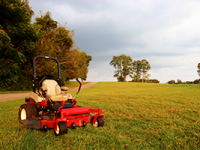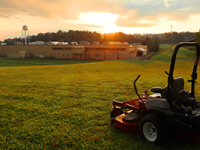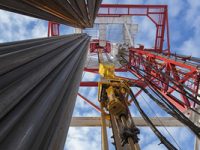Read This if Your Wind Turbines are Overheating
 Rising temperatures – which lead to water evaporation and loss of coolants in critical wind turbine cooling systems – may cause 1.5 MW wind turbines to overheat. Fortunately, there’s a solution to help keep your wind turbines running efficiently and in good working order.
Rising temperatures – which lead to water evaporation and loss of coolants in critical wind turbine cooling systems – may cause 1.5 MW wind turbines to overheat. Fortunately, there’s a solution to help keep your wind turbines running efficiently and in good working order.
If you are operating a 1.5 MW wind turbine with an open-loop cooling system, you may have a costly problem on your hands – one that you might not even be aware of. By its nature, the open-loop system allows for water to gradually evaporate from the water-glycol coolant in the insulated gate bipolar transistor (IGBT) circuit, especially during warm weather. Water evaporation lowers the coolant level and elevates the mixture’s concentration, inhibiting the cooling properties of the fluid and potentially compromising the IGBT.
Loss of those IGBT components due to wind turbines overheating result in significant downtime and hardware losses, to replace. To avoid this, wind turbine maintenance teams commonly “bandage” the problem with a regular cadence of coolant monitoring, water replenishment and re-balancing of the cooling fluid mix. But this costly maintenance solution requires taking both the turbine and transformer offline – resulting in significant downtime and revenue loss for the wind farm.
 For more detail on how our engineers’ design custom, precision-engineered solutions that help even the most sophisticated wind power generation plants produce renewable energy more efficiently while improving reliability and up-time download, our wind turbine solutions brochure.
For more detail on how our engineers’ design custom, precision-engineered solutions that help even the most sophisticated wind power generation plants produce renewable energy more efficiently while improving reliability and up-time download, our wind turbine solutions brochure.
The high cost of maintaining IGBT water-glycol cooling systems (1.5 MW wind turbines)
As owners and operators are spending budgets and time to maintain IGBT coolant levels in open-atmosphere cooling systems, the overall cost of maintenance, replacement fluids, and reduced reliability adds up quickly. The solution our engineers designed eliminates water evaporation by containing the water vapor in a closed loop add-on system, then condensing it back into a liquid to maintain a constant water-glycol ratio maintenance to optimize the cooling system’s efficiency. The results are reduced monitoring and improved turbine reliability – which net higher productivity and uninterrupted power generation and revenue streams for customers.
What is the KleenVent KV-CEI technology and how does the product work?
 The KleenVent KV-CEI is part of a larger family of products designed to isolate hydraulic systems from airborne contaminants, dust, chemicals and water vapor evaporation. The KV-CEI enclosure solution works by closing off the coolant loop system from the outside atmosphere (where evaporation escapes) with a breather bladder. This bladder allows the outside air to inflate and deflate the bladder as fluid levels inside the isolation tank expand and contract due to system liquid temperature changes. A low-pressure relief valve helps prevent system over-pressurization in the case of unforeseen air trapped inside the fluid lines, and an open-close air exhausting valve allows the system to be drained and refilled quickly with the proper fluid levels during a normal preventative maintenance cycle. The current KV-CEI design is versatile enough to allow the addition of low-level liquid sensors when needed. We also can design many mounting options designed to fit a particular mounting pattern. As a testament, the KV-CEI technology is deployed in wind turbine systems for one of the world’s leading wind turbine manufacturers.
The KleenVent KV-CEI is part of a larger family of products designed to isolate hydraulic systems from airborne contaminants, dust, chemicals and water vapor evaporation. The KV-CEI enclosure solution works by closing off the coolant loop system from the outside atmosphere (where evaporation escapes) with a breather bladder. This bladder allows the outside air to inflate and deflate the bladder as fluid levels inside the isolation tank expand and contract due to system liquid temperature changes. A low-pressure relief valve helps prevent system over-pressurization in the case of unforeseen air trapped inside the fluid lines, and an open-close air exhausting valve allows the system to be drained and refilled quickly with the proper fluid levels during a normal preventative maintenance cycle. The current KV-CEI design is versatile enough to allow the addition of low-level liquid sensors when needed. We also can design many mounting options designed to fit a particular mounting pattern. As a testament, the KV-CEI technology is deployed in wind turbine systems for one of the world’s leading wind turbine manufacturers.
How does it work in the system?
 The KV-CEI reservoir bladder barrier creates a closed atmosphere that expands and contracts with temperature- and atmospheric pressure-induced changes. Isolating the internal volume of the reservoir from the existing outside atmosphere prevents both evaporation of water from and the ingress of airborne contaminants into the water-glycol solution. A check valve provides over-pressure protection, and a visual level indicator allows local confirmation of the coolant level. An additional port is included to accommodate an optional, industry-standard, liquid level float switch for remote low-level coolant indication.
The KV-CEI reservoir bladder barrier creates a closed atmosphere that expands and contracts with temperature- and atmospheric pressure-induced changes. Isolating the internal volume of the reservoir from the existing outside atmosphere prevents both evaporation of water from and the ingress of airborne contaminants into the water-glycol solution. A check valve provides over-pressure protection, and a visual level indicator allows local confirmation of the coolant level. An additional port is included to accommodate an optional, industry-standard, liquid level float switch for remote low-level coolant indication.
“Your return on investment for the KV-CEI solution can be measured in as little as a few short weeks in warmer climates and at elevated operating temperatures; meaning a quick investment in our solution can provide break-even expenditures by summer’s end, along with continued productivity savings for the life of the wind turbine.”
Robert J. Marotta, product sales manager, Accumulator Cooler Division, Parker Hannifin
Ready to maximize your wind turbine’s performance and improve efficiency? Our engineers’ design custom, precision-engineered solutions that help even the most sophisticated wind power plants generate renewable energy more efficiently while improving reliability and uptime. For more detail, download our wind turbine solutions brochure.
Headed to AWEA Windpower conference?
Visit Parker booth #4244 at AWEA Windpower, May 8‐10 in Chicago, Illinois.
From integrated lube oil filtration systems and compact blade actuation systems to sealing technologies and power conversion systems, Parker has the custom, precision-engineered solutions that help the most sophisticated wind power plants generate energy more efficiently while improving reliability and uptime. Stop by our booth and get your questions answered.
Learn more about our featured products at AWEA Windpower by visiting our wind power solutions page.



Article contributed by RJ Marotta, product sales manager, Accumulator and Cooler Division, Robert Salzer, industry market manager – wind turbines, Mark Chapman, global OEM manager, Parker Hannifin.
Related content for you
Condition Monitoring Solutions for Power Generation Plants
Innovative New Fluid Purifier Saves Time, Money in Hydroelectric Plants
New Hybrid Actuation System Ideal for Renewable Energy Applications
Source: Parker Feed





